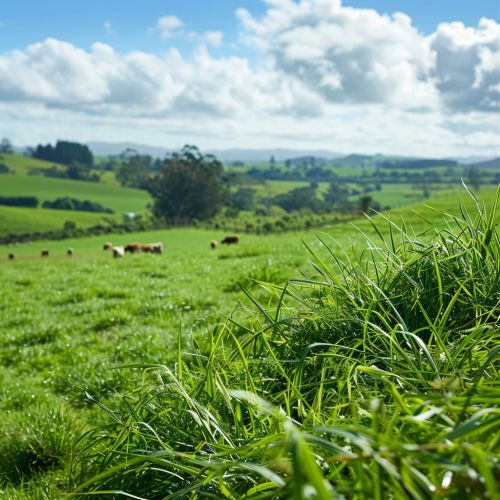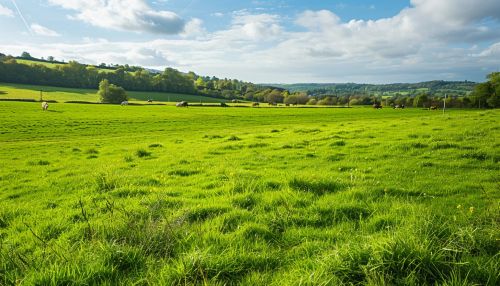Forage Crops: Difference between revisions
(Created page with "== Introduction == Forage crops are plants grown primarily to provide feed for livestock. These crops play a crucial role in the agricultural ecosystem, contributing to the nutrition of animals and the sustainability of farming practices. Forage crops are typically grasses, legumes, or other herbaceous plants that are either grazed by livestock directly in the field or harvested and stored as hay, silage, or green chop. This article delves into the various types of forag...") |
No edit summary |
||
| (One intermediate revision by the same user not shown) | |||
| Line 65: | Line 65: | ||
Forage crops are a cornerstone of livestock production and sustainable agriculture. By understanding the types, nutritional value, management practices, and economic importance of forage crops, farmers can optimize their use and contribute to a more sustainable and profitable agricultural system. | Forage crops are a cornerstone of livestock production and sustainable agriculture. By understanding the types, nutritional value, management practices, and economic importance of forage crops, farmers can optimize their use and contribute to a more sustainable and profitable agricultural system. | ||
[[Image:Detail-79329.jpg|thumb|center|A lush green pasture with a variety of forage crops including grasses and legumes, with grazing livestock in the background.|class=only_on_mobile]] | |||
[[Image:Detail-79330.jpg|thumb|center|A lush green pasture with a variety of forage crops including grasses and legumes, with grazing livestock in the background.|class=only_on_desktop]] | |||
== See Also == | == See Also == | ||
Latest revision as of 02:42, 18 May 2024
Introduction
Forage crops are plants grown primarily to provide feed for livestock. These crops play a crucial role in the agricultural ecosystem, contributing to the nutrition of animals and the sustainability of farming practices. Forage crops are typically grasses, legumes, or other herbaceous plants that are either grazed by livestock directly in the field or harvested and stored as hay, silage, or green chop. This article delves into the various types of forage crops, their management, nutritional value, and their significance in sustainable agriculture.
Types of Forage Crops
Forage crops can be broadly categorized into grasses, legumes, and other herbaceous plants. Each category has unique characteristics and benefits.
Grasses
Grasses are the most common type of forage crop and include species such as timothy, ryegrass, and bermudagrass. These plants are known for their high fiber content and ability to thrive in a variety of climates and soil types.
Legumes
Leguminous forage crops, such as alfalfa, clover, and vetch, are highly valued for their high protein content and ability to fix atmospheric nitrogen, thereby improving soil fertility. These plants often complement grasses in mixed pastures, enhancing the overall nutritional value of the forage.
Other Herbaceous Plants
Other herbaceous plants used as forage include brassicas like kale and turnips, which are often used in rotational grazing systems. These plants can provide high-quality forage, especially during periods when traditional grasses and legumes are less productive.
Nutritional Value
The nutritional value of forage crops is a critical factor in livestock production. The primary components of forage nutrition include fiber, protein, energy, vitamins, and minerals.
Fiber
Fiber is essential for the proper functioning of the ruminant digestive system. Forage crops like grasses are particularly high in fiber, which helps in maintaining gut health and promoting efficient digestion.
Protein
Protein is vital for growth, reproduction, and milk production in livestock. Leguminous forage crops are especially rich in protein, making them an excellent addition to a balanced diet for animals.
Energy
The energy content of forage crops is primarily derived from carbohydrates. High-energy forage crops, such as certain varieties of corn used for silage, are crucial for meeting the energy demands of high-producing animals.
Vitamins and Minerals
Forage crops also provide essential vitamins and minerals, such as calcium, phosphorus, and vitamins A and E. These nutrients are necessary for various physiological functions, including bone development, immune response, and reproduction.
Forage Crop Management
Effective management of forage crops involves several practices aimed at optimizing yield, quality, and sustainability.
Soil Fertility
Maintaining soil fertility is fundamental to successful forage crop production. This includes regular soil testing, appropriate fertilization, and the use of cover crops to enhance soil organic matter and nutrient availability.
Irrigation
Irrigation is crucial in regions with insufficient rainfall. Techniques such as drip irrigation and sprinkler systems can help ensure that forage crops receive adequate water, promoting healthy growth and high yields.
Pest and Disease Control
Integrated pest management (IPM) strategies are essential for controlling pests and diseases in forage crops. This includes the use of resistant varieties, biological control agents, and judicious application of pesticides.
Harvesting
The timing and method of harvesting forage crops significantly impact their nutritional value and storage quality. For example, hay should be harvested at the optimal stage of maturity to maximize nutrient content and minimize losses during drying and storage.
Sustainable Forage Production
Sustainable forage production practices are designed to enhance environmental health, economic profitability, and social and economic equity.
Rotational Grazing
Rotational grazing involves moving livestock between pastures to allow forage crops to recover and regrow. This practice helps maintain pasture productivity, reduce soil erosion, and improve animal health.
Cover Cropping
Cover cropping involves planting specific crops during off-seasons to protect and improve soil health. Cover crops can prevent soil erosion, enhance soil fertility, and suppress weeds, contributing to sustainable forage production.
Reduced Tillage
Reduced tillage practices, such as no-till or minimum-till farming, help preserve soil structure, reduce erosion, and enhance water retention. These practices are beneficial for maintaining long-term soil health and productivity.
Economic Importance
Forage crops are economically significant for several reasons. They provide a cost-effective source of feed for livestock, reduce the need for purchased feed, and contribute to the overall profitability of farming operations. Additionally, forage crops can be a source of income through the sale of hay, silage, and other forage products.
Challenges in Forage Crop Production
Despite their benefits, forage crop production faces several challenges, including climate variability, pest and disease pressures, and the need for sustainable management practices. Addressing these challenges requires ongoing research, innovation, and the adoption of best practices.
Conclusion
Forage crops are a cornerstone of livestock production and sustainable agriculture. By understanding the types, nutritional value, management practices, and economic importance of forage crops, farmers can optimize their use and contribute to a more sustainable and profitable agricultural system.


